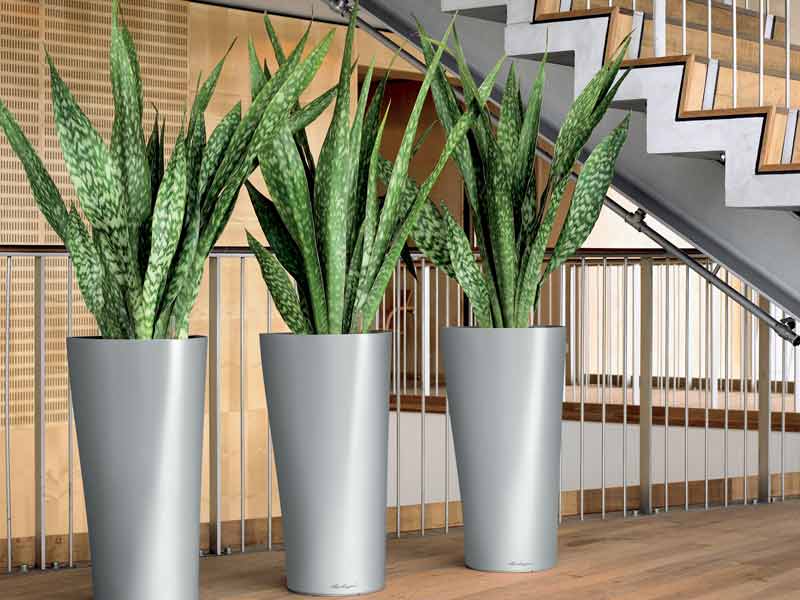Part one of a three part series

Bold Sanseviera plants in striking pots make a statement and improve the indoor environment without wasting water.
California’s drought and the need to conserve water in every way possible is a concern for everyone. Outdoor gardeners have been asked to do their part for a long time, and they are helping by getting rid of their thirsty lawns and other plants that require more water than our Mediterranean climate allows.
But a lot of us don’t have yards or gardens, and our plants are all inside. Did you know that indoor plants need very little water? Good Earth Plant Company’s technicians water some plants less than once a month. Depending upon the size, variety and type of plants in your home or office, the total amount of water you use monthly should be 50 gallons or less. Stop yourself from overwatering and you will quickly save a few gallons.
If you want to play a bigger part in conserving water, there are many ways to save water when caring for houseplants. When you design and install plantscaping at your home, office, or apartment, make smart plant choices and practice waterwise care, and you can preserve this resource.
Do you need a little motivation? Let’s remind ourselves how precious water is on this planet:
- Only a little over two percent of the world’s water is fresh water and only one percent is accessible drinking water.
- Our bodies are approximately 70 percent water. Our brains are 85 percent and even are bones are made of 15 percent water.
- If the water in our bodies drops just two and a half percent, our mental and physical efficiency drops 25 percent. If you feel thirsty, you are already on your way to this standard of dehydration.
- We can only live without water for approximately 10 days.
- Every living thing on Earth, including everything that ensures our survival, depends on clean, potable water.
But we also get tremendous benefits from plants in our environment. You actually get the most benefits from plants in your indoor environment: your office, home, and recreational environments like stores and restaurants. We’ve written about this many times. There are ways to save water when caring for indoor plants just like conserving water use by your outdoor plants.

It only takes a few carefully chosen plants to change the feeling of a room without a big investment in watering. These edgy tall Sansevieria compliment the energy of the bright colors.
First, choose plants indoors that use less water. Obvious choices include succulents. Other excellent choices:
- Spider Plants
- Dracaena Marginata
- Chinese Evergreen
- ZZ Plant
- Cast Iron Plant
- Christmas Cactus
- Sansevieria
Many people overwater their houseplants to begin with. They end up killing them with kindness. More houseplants die due to overwatering than any other reason, including underwatering. When plants are overwatered, the soil is so soggy no oxygen reaches the roots. The roots can’t “breathe,” they die and they rot.
If you choose plants that require less water, most need periods of dry soil for days or even weeks at a time. Watch for any leaves wilting. This is a sign of water stress. Also watch for leaf drop or yellowing.
Some great ways to water your houseplants:
Water houseplants with ice cubes. Ice cubes will absorb slowly, preventing excess water running out. Ever drop ice cubes on the floor from your dispenser? Perfect for your plants.
Install sub-irrigation systems. Sub-irrigations systems provide the amount of water that a plant needs as it needs it, with no under or over watering.
Reuse old water. Have you ever left a glass of water on your desk or nightstand, and found that stagnant water later? Water a houseplant with it.
Stash a watering can. Bring a nice garden watering can inside and keep it somewhere handy, such as under your kitchen sink. When you have even a little extra water, toss it into the watering can. It will be ready when your plants are ready for a drink.
A tasty idea. Try saving the water from your dinner preparations. When you boil pasta or potatoes, don’t throw out the starchy pot of water. Your plants will think it’s delicious. But be sure the water has cooled before you use it. One of the best, non-toxic ways to kill weeds is to pour boiling water of them. So if you don’t want to kill your houseplants, let the pot cool on the stove before you use it. Or if you want to use it to kill weeds without chemicals, you have a new option.
In part two of our series, we will tell how little water is used in vertical gardens, and ways to save here too.
